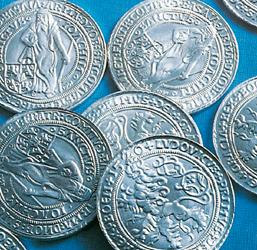The Thaler (or Taler) was a silver coin used throughout Europe for almost four hundred years. Its name lives on in various currencies as the dollar or tolar. Etymologically, "Thaler" is an abbreviation of "Joachimsthaler", a coin type from the city of Joachimsthal in Bohemia, where some of the first such coins were minted in 1518.
Origin
By 1518 guldiners were popping up everywhere in central Europe. In Bohemia, a part of the Holy Roman Empire then controlled by the Habsburg monarchs, a guldiner was minted—of similar physical size but slightly less fineness—that was named the Joachimsthaler from the silver mined by the Counts von Schlick at a rich source near Joachimsthal (St. Joachim's Valley, Czech: Jáchymov) (now in the Czech Republic) where Thal (Tal) means "valley" in German. Joachim, the father of the Virgin Mary, was portrayed on the coin. Similar coins began to be minted in neighbouring valleys rich in silver deposits, each named after the particular 'thal' or valley from which the silver was extracted. There were soon so many of them that these silver coins began to be known more widley as 'thaler'. From these earliest 'thalaer' developed the new Thaler - the coin that Europe had been looking for to create a standard for commerce.
The Joachimsthaler
The zenith of Thaler minting occurred in the late 16th and 17th centuries with the so-called "multiple Thalers", often called lösers in Germany. The first were minted in Brunswick, and indeed the majority were struck there. Some of these coins reached colossal size, as much as sixteen normal thalers. The original reason for minting these colossal coins, some of which exceeded a full pound (over 450g) of silver and being over 12 cm in diameter, is uncertain. The name "löser" most likely was derived from a large gold coin minted in Hamburg called the Portugalöser, worth 10 ducats. Some of the silver löser reached this value, but not all. Eventually the term was applied to numerous similar coins worth more than a single Thaler. These coins are very rare, the larger ones often costing tens of thousands of dollars, and are highly sought after by serious collectors of Thalers. Few circulated in any real sense so they often remain in well-preserved condition.
In the Holy Roman Empire, the Thaler was used as the standard against which the various states' currencies could be valued. One standard was the Reichsthaler, which contained one ninth of a Cologne mark of silver. In 1754, the Conventionsthaler was introduced, containing one tenth of a Cologne mark of silver.
Prussia used a Thaler containing one fourteenth of a Cologne mark of silver. In 1837, the Prussian Thaler became part of a new currency used in southern Germany and the Rhineland, with the Gulden (equal to 4/7 Thaler) as the standard unit of account. By 1850, nearly all German states used this standard of Thaler, though with various different subdivisions.
In 1857, the Vereinsthaler was adopted in the Austro-Hungarian Empire and through most of Germany. Vereinsthalers continued to be issued until 1872 in Germany and 1867 in Austria-Hungary. Maria Theresa thaler was still used during 20th century in Abyssinia and throughout Middle East.
Dutch daalder
The Thaler was introduced and became the most widespread currency in Scandinavia under the name daler during the early 17th century. Various daler circulated, including the Danish rigsdaler, the Swedish riksdaler and the Norwegian speciedaler. These daler circulated in Denmark and Sweden until 1873 when they were replaced by the Danish krone and Swedish krona, the new currencies introduced by the Scandinavian Monetary Union. Norway joined the Monetary Union and introduced the Norwegian krone in 1876.
Scandinavian taler
As silver flooded into the European economy from domestic and overseas sources, Thalers and Thaler-sized coins were minted all over with equivalent coins such as the crown, daalder from which the English word dollar is derived, krona, and from 1497, the Spanish 8 reales piece was minted - a coin which would later become known in some parts of the world as the peso. Indeed, in England the word dollar was in use for the Thaler for 200 years before the issue of the United States dollar, and until the half crown ceased to be used following decimalisation in 1971, the term "half a dollar" could be heard for "half a crown".
Other "Thaler"
No currency currently in circulation is named thaler. Several, however, are acknowledging its legacy with their names: twenty-three currencies named dollar, used in countries including Australia, Canada, Hong Kong, New Zealand and United States of America, as well as tolar, used in Slovenia until the end of 2006.
 Chronology of Thaler development
Chronology of Thaler developmentMaria Theresa Thaler
Reichsthaler
Kronenthaler
Vereinsthaler
Groschen
1 comment:
酒店經紀菲梵,酒店經紀~free fun~,酒店經紀,酒店經紀,酒店上班,酒店上班,酒店小姐,酒店小姐,酒店工作,酒店工作,酒店打工,酒店打工,酒店兼差,酒店兼差,酒店兼職,酒店兼職,經紀人,經紀人,禮服店,禮服店,便服店,便服店,
Post a Comment